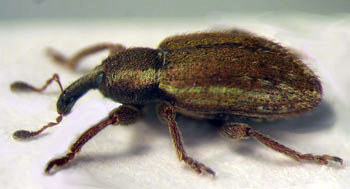Pests
Hypera nigrirostris F. - Lesser Clover Leaf Weevil
Systematic position.
Class Insecta, order Coleoptera, family Curculionidae, genus Hypera Germar.Synonyms.
Phytonomus nigrirostris F.Biological group.
Pest of the clover.Morphology and biology.
Body length is 3-4 mm. Body is black, antennae and legs reddish. Rostrum 3 times as long as it is wide, constricted before head. Eyes large and transverse, not protruding beyond head contour. Frons narrower than rostral dorsum. Pronotum weakly transverse, its lateral sides widely rounded. Basal half of elytra parallel-sided, with distinct humeral prominences. Disc of pronotum covered mainly with hairlike scales, its midline and lateral sides covered with green-goldish dissected scales. Elytral pubescence monochromatic green with metallic shine and formed of deeply dissected scales. Odd intervals on elytral declivity have pointed semi-erect long and whitish setae. Leg pubescence is hairlike. Adults hibernate on the fields under the plant litter. Diapause of adults terminates at air temperature 7-9°C. Soon mating and oviposition begin. In northern part of area, mass oviposition occurs from mid-May until beginning of June. Female gnaws hole on epidermis and lays down eggs one by one or by group. Every day the female lays about 8 eggs; total fertility is about 800 eggs. Embryogenesis lasts 10-25 days. Hatching larvae appear at the end of May and develop openly in leaf sheaths and inflorescences or within closed young leaves. Its development lasts 21-23 days. The larva makes a cocoon in the clover flowerhead 2-3 days before pupation. The first pupae occur at the end of June. It develops 5-9 days. Development of the generation lasts 34-45 days. Diapause begins in August in the northern part of area.Distribution.
Europe, Northern Africa, introduced to the Northern America and Japan. In the former USSR, it inhabits the European part of the former USSR northward to Arkhangelsk Region and Komi Republic, the whole Caucasus, the south of West and East Siberia, the Far East, Middle Asia, and Kazakhstan.Ecology.
Monovoltine. Oligophage, prefers Trifolium pratense L., T. hybridum L., T. repens L. Rarely injures alfalfa, pea, and vetch. Adult gnaws holes in leaves and small pits in leafstalks and stems. Adults appear in spring 10-12 days earlier than Protapion apricans; peak of their abundance occur in the beginning of June. About 20% or more of population are usually infested with parasites; e.g., Dibrachoides dynastes Forst., Anaphes iole Gir., Bathyplectes sp., Microbracon sp.Economic significance.
The pest damages mainly in larval stage. Larva selects the biggest apical buds and inflorescences, so its damage increases. Every larva injures 3-4 inflorescences. In Byelorussia about 6.6-88.5% plants are injured on the clover fields. Control measures include cutting of clover during period of high larva abundance and removal of plant residues from fields in autumn. Pesticide treatment is necessary in spring on seed clover crops against Hypera nigrirostris and Protapion apricans concurrently after mass emergence of the beetles.Reference citations:
Dmitrieva, I.N. 2005. Fauna and ecological peculiarities of the Curculionoidea (Coleoptera) in northern forest-steppe zone of the Volga region hills. Monograph. Cheboksary: Nizhnii Novgorod University, 180 p. (in Russian).Glushchenko, A.F. 1955. Hypera nigrirostris F. (Coleoptera, Curculionidae) . the pest of the clover in Leningrad Region. Entomol. obozr., 34: 99-107 (in Russian).
Ioannisiani, T.G. 1963. A population dynamics of the Phytonomus meles F. and Phytonomus nigrirostris F. on clover. Zool. Zhurn., 42(12), 1810-1816 (in Russian).
Ioannisiani, T.G. 1972. The weevils (Coleoptera, Curculionidae) of Byelorussia. Minsk: Nauka i Tekhnika, 352 p. (in Russian).
Korotyaev, B.A. 1983. Family Curculionidae. In : Kopaneva, L.M., ed. Keys to harmful and useful insects and mites of the annual and perennial grasses and leguminous plants in the USSR. Leningrad: Kolos, p. 115-127 (in Russian).
Zaslavskii, V.A. 1961. Review of the species of the genus Phytonomus Schonh. (Copeoptera, Curculionidae) in the fauna of the USSR. Entomol. Obozr., 60(3): 625-635 (in Russian).
© David'yan G.E. (text & picture)


